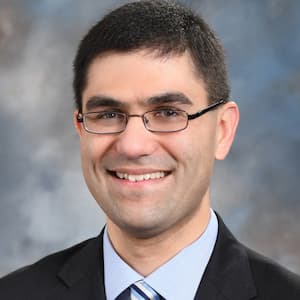News
Article
Real-World Evidence Continues to Build Hope for People with Psoriatic Arthritis
Author(s):
Real-world analyses help patients and their healthcare providers make more informed and personalized treatment decisions with the goal of long-term symptomatic relief.
While clinical trials continue to be the gold standard for testing the safety and efficacy of new therapies and innovative medical approaches, real-world evidence (RWE) studies can help provide data about a broader cross-section of patients seen in daily clinical practice. This is because RWE studies are conducted outside of controlled clinical trial settings and can offer information about a wide range of patients treated by healthcare providers that do not typically reflect homogeneous patient groups found in clinical trials. The evidence gathered in these real-world studies empower healthcare providers and patients to make more informed decisions about treatment.
Soumya Chakravarty, MD, PhD, FACP, FACR
Credit: ResearchGate

The Value for RWE in PsA
Active psoriatic arthritis (PsA) is a chronic condition that occurs when the body’s immune system attacks healthy cells and tissue, which causes inflammation in the joints as well as overproduction of skin cells.1 About 1.5 million Americans are living with active PsA, and although patients may experience symptoms differently, the condition can often interfere with basic daily activities.2,3 Despite its prevalence in the U.S. and our understanding of the disease, underdiagnosis and, subsequently, undertreatment of patients remains a challenge.
For those living with PsA, the journey to an effective treatment that can help relieve debilitating symptoms, and perhaps even slow the progression of disease, can be quite long and challenging. This is because common symptoms of PsA, such as joint stiffness, pain and swelling, may be mistaken for other ailments.4 Additionally, some patients with active PsA can experience fatigue, which is an underestimated and underreported concern that can interfere with daily life.5,6 Over time, if left untreated, this condition can progress and lead to joint damage.
Additionally, because sometimes patients do not see a specialist, symptoms can be overlooked or underestimated. This means it can take some time to get an accurate diagnosis and a treatment plan that can help.
I recently had the pleasure of sharing new insights from Janssen’s research in active PsA at the Maui Derm NP+PA Summer 2023 meeting that will help healthcare providers as we continue to work with patients to develop treatment plans that address their PsA domains of disease and embrace shared decision-making.
The data, Six-Month Persistence and Multi-Domain Effectiveness of Guselkumab Among Real-world Psoriatic Arthritis Patients in the CorEvitas Psoriatic Arthritis/Spondyloarthritis Registry, demonstrated that patients with 6 months of follow-up and persistent guselkumab (TREMFYA) use had statistically significant improvements in joint disease, skin disease, and patient-reported pain.
Here are some highlights of what we found within the data analysis:
- Nearly 80% of patients had persistent guselkumab use at six months. This was despite patients having, on average, long-standing and treatment refractory PsA at the time of guselkumab initiation.
- This real-world evidence supports the robust retention of guselkumab-treated patients (≥90%) in randomized clinical trials.
- Patients with 6 months of persistent guselkumab use experienced statistically significant improvements in peripheral joint disease, skin disease, and patient-reported pain – supporting clinical trial results demonstrating the benefit guselkumab in improving the signs and symptoms of active PsA.
Analyses like these help patients and their healthcare providers make more informed and personalized treatment decisions with the goal of long-term symptomatic relief.This is essential, considering PsA is a chronic and progressive disease, and its severity can vary from patient to patient. Through scientific research and patient support efforts, our hope is to empower PsA patients and helping them prioritize their overall well-being.
Chakravarty, MD, PhD, FACP, FACR, is Senior Director, Strategic Lead, within the Rheumatology Therapeutic Area at Janssen Immunology.
References
- Mayo Clinic. Psoriatic Arthritis. Accessed June 22, 2023. https://www.mayoclinic.org/diseases-conditions/psoriatic-arthritis/symptoms-causes/syc-20354076.
- Kavanaugh, A., Helliwell, P., & Ritchlin, C. T. Psoriatic Arthritis and Burden of Disease: Patient Perspectives from the Population-Based Multinational Assessment of Psoriasis and Psoriatic Arthritis (MAPP) Survey. Rheumatology and therapy, 3(1), 91–102. (2016). Accessed June 22, 2023. https://doi.org/10.1007/s40744-016-0029-z
- Johns Hopkins. Psoriatic Arthritis. Accessed June 22, 2023. https://www.hopkinsarthritis.org/arthritis-info/psoriatic-arthritis/#:%7E:text=What%20is%20Psoriatic%20Arthritis%3F,may%20also%20affect%20the%2
- National Psoriasis Foundation. About Psoriatic Arthritis. Accessed June 22, 2023. https://www.psoriasis.org/about-psoriatic-arthritis/.
- CreakyJoints. What Does Psoriatic Arthritis Fatigue Really Feel Like? Accessed June 1, 2022. https://creakyjoints.org/about-arthritis/psoriatic-arthritis/psa-symptoms/what-psoriatic-arthritis-fatigue-feels-like/
- Nowell, W.B., Gavigan, K., Kannowski, C.L. et al. Which Patient-Reported Outcomes Do Rheumatology Patients Find Important to Track Digitally? A Real-World Longitudinal Study in ArthritisPower. Arthritis Res Ther 23, 53 (2021). https://doi.org/10.1186/s13075-021-02430-0





